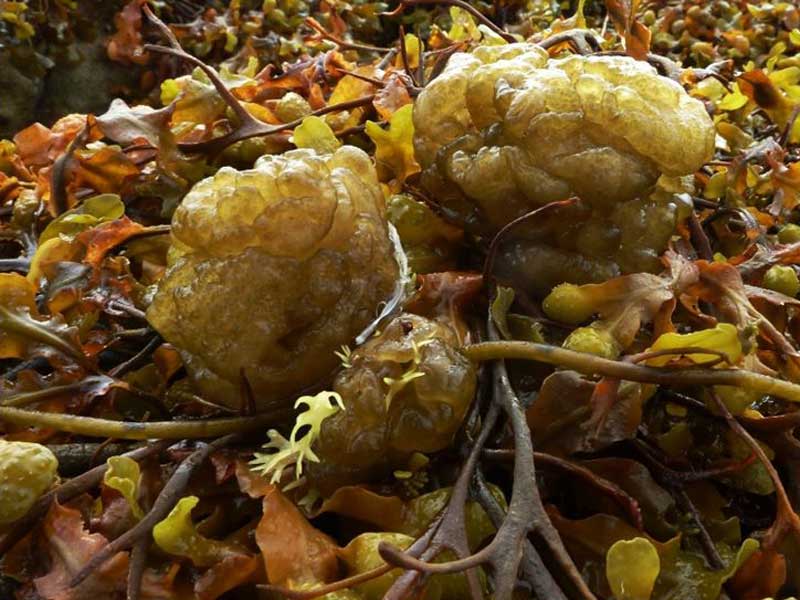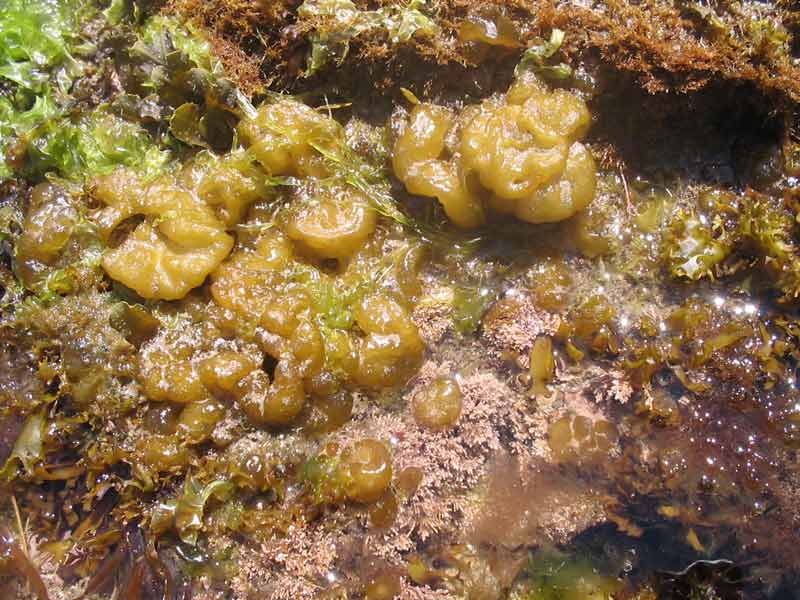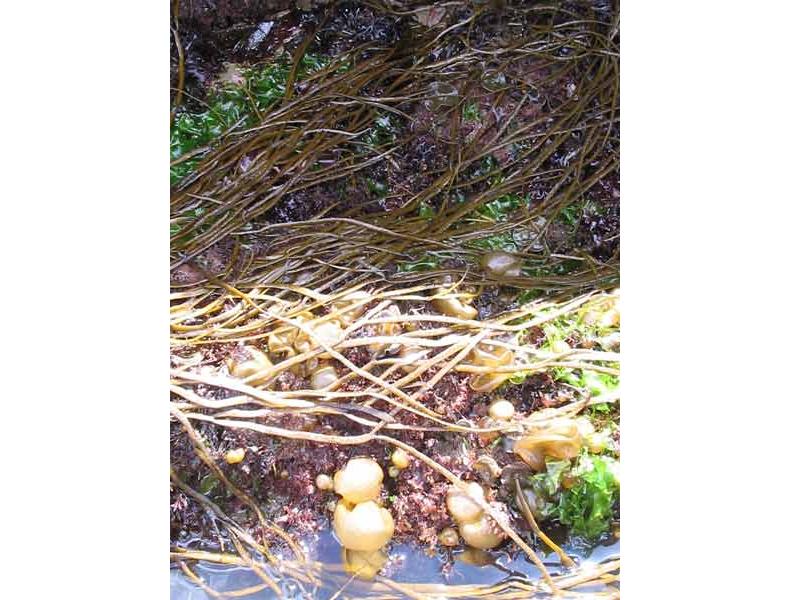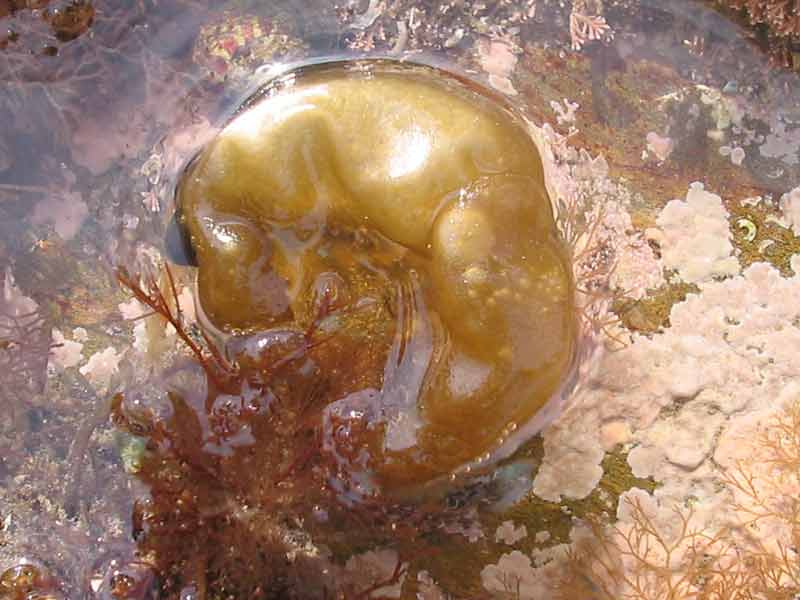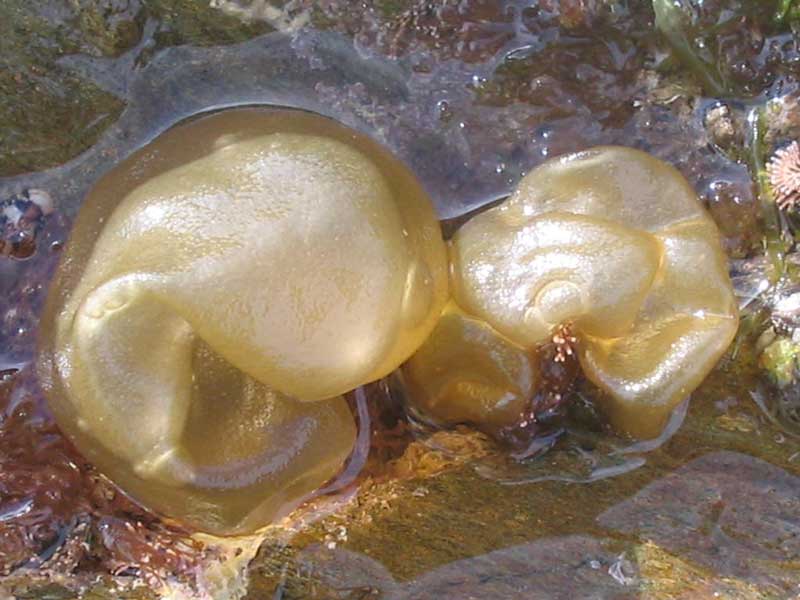Oyster thief (Colpomenia peregrina)
Distribution data supplied by the Ocean Biodiversity Information System (OBIS). To interrogate UK data visit the NBN Atlas.Map Help
| Researched by | Judith Oakley | Refereed by | Admin |
| Authority | Sauvageau, 1927 | ||
| Other common names | - | Synonyms | - |
Summary
Description
Colpomenia peregrina is a non-gelatinous brown alga. It is greenish-olive in colour with fine brown dots. It forms a thin-walled hollow sphere, usually 1-7 cm in diameter. It may be confused with the native Leathesia difformis which is lobed with a gelatinous surface. Colpomenia peregrina is dry and papery to the touch and can be torn easily.
Recorded distribution in Britain and Ireland
Colpomenia peregrina is distributed throughout Britain with larger populations on western coasts.Global distribution
Colpomenia peregrina has a world-wide distribution ini temperate waters. In Europe it is found from Iberia to southern Norway.Habitat
Colpomenia peregrina occurs on rock, other seaweeds and shells. The species is usually epiphytic, growing on a variety of seaweeds in mid-tide rockpools and down to the sub-littoral region. It thrives in sheltered areas.Depth range
-Identifying features
- A thin-walled sphere.
- Greenish-olive with brown spots.
- Usually 1-7 cm in diameter.
Additional information
Colpomenia peregrina occurs naturally in the Pacific Ocean. It was introduced to France with with juvenile Crassostrea virginica from the Pacific coast of North America. Colpomenia peregrina was introduced in 1907 from France into Cornwall and Dorset. It has negligible effects on the environment. In other countries, it grows attached to oysters and floats away with the oyster when the air-filled thalli grow large enough. Hence the common name of oyster thief.
Listed by
- none -
Bibliography
Cotton, A.D., 1908. Colpomenia sinuosa in Britain. Journal of Botany, 46, 82-83.
Dickinson, C.I., 1963. British seaweeds. London & Frome: Butler & Tanner Ltd.
Eno, N.C., Clark, R.A. & Sanderson, W.G. (ed.) 1997. Non-native marine species in British waters: a review and directory. Peterborough: Joint Nature Conservation Committee.
Hayward, P., Nelson-Smith, T. & Shields, C. 1996. Collins pocket guide. Sea shore of Britain and northern Europe. London: HarperCollins.
Howson, C.M. & Picton, B.E., 1997. The species directory of the marine fauna and flora of the British Isles and surrounding seas. Belfast: Ulster Museum. [Ulster Museum publication, no. 276.]
Laverack, M.S. & Blackler, D.M., 1974. Fauna & Flora of St. Andrews Bay. Scottish Academic Press (Edinburgh & London).
MarLIN (Marine Life Information Network), 2005. SEArchable BEnthic Data (SEABED) Map [on-line]. Data Access Sub-programme, Marine Life Information Network for Britian and Ireland http://www.marlin.ac.uk,
Price, J.H., Irvine, D.E. & Farnham, W.F., 1980. The shore environment. Volume 2: Ecosystems. London Academic Press.
Datasets
Centre for Environmental Data and Recording, 2018. Ulster Museum Marine Surveys of Northern Ireland Coastal Waters. Occurrence dataset https://www.nmni.com/CEDaR/CEDaR-Centre-for-Environmental-Data-and-Recording.aspx accessed via NBNAtlas.org on 2018-09-25.
Cofnod – North Wales Environmental Information Service, 2018. Records of Invasive Non Native Species held on the Cofnod database. Occurrence dataset: https://doi.org/10.15468/nxdbhu accessed via GBIF.org on 2018-09-25.
Fenwick, 2018. Aphotomarine. Occurrence dataset http://www.aphotomarine.com/index.html Accessed via NBNAtlas.org on 2018-10-01
Fife Nature Records Centre, 2018. St Andrews BioBlitz 2014. Occurrence dataset: https://doi.org/10.15468/erweal accessed via GBIF.org on 2018-09-27.
Fife Nature Records Centre, 2018. St Andrews BioBlitz 2015. Occurrence dataset: https://doi.org/10.15468/xtrbvy accessed via GBIF.org on 2018-09-27.
Kent Wildlife Trust, 2018. Kent Wildlife Trust Shoresearch Intertidal Survey 2004 onwards. Occurrence dataset: https://www.kentwildlifetrust.org.uk/ accessed via NBNAtlas.org on 2018-10-01.
Manx Biological Recording Partnership, 2018. Isle of Man historical wildlife records 1990 to 1994. Occurrence dataset: https://doi.org/10.15468/aru16v accessed via GBIF.org on 2018-10-01.
National Trust, 2017. National Trust Species Records. Occurrence dataset: https://doi.org/10.15468/opc6g1 accessed via GBIF.org on 2018-10-01.
NBN (National Biodiversity Network) Atlas. Available from: https://www.nbnatlas.org.
OBIS (Ocean Biodiversity Information System), 2024. Global map of species distribution using gridded data. Available from: Ocean Biogeographic Information System. www.iobis.org. Accessed: 2024-05-13
Outer Hebrides Biological Recording, 2018. Invasive Non-Native Species, Outer Hebrides. Occurrence dataset: https://doi.org/10.15468/30erdy accessed via GBIF.org on 2018-10-01.
Royal Botanic Garden Edinburgh, 2018. Royal Botanic Garden Edinburgh Herbarium (E). Occurrence dataset: https://doi.org/10.15468/ypoair accessed via GBIF.org on 2018-10-02.
South East Wales Biodiversity Records Centre, 2018. INNS Data: All Taxa (South East Wales). Occurrence dataset: https://doi.org/10.15468/crhjs2 accessed via GBIF.org on 2018-10-02.
South East Wales Biodiversity Records Centre, 2018. SEWBReC Algae and allied species (South East Wales). Occurrence dataset: https://doi.org/10.15468/55albd accessed via GBIF.org on 2018-10-02.
Citation
This review can be cited as:
Last Updated: 29/05/2008

